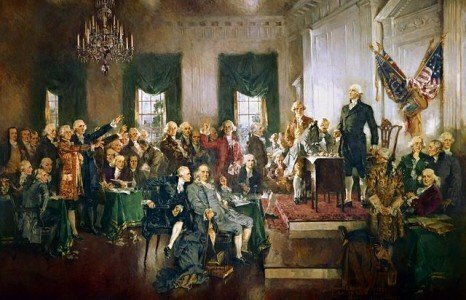On September 17, 1787, a group of men gathered in a closed meeting room to sign the greatest vision of human freedom in history, the U.S. Constitution. And it was Benjamin Franklin who made the motion to sign the document in his last great speech.
The Constitutional Convention started in May 1787 in Pennsylvania’s State House (which is now called Independence Hall). During four months of deliberations, the delegates drew up a plan for a new form of republican government that replaced a weak central government established by the Articles of Confederation.
George Washington presided over the Convention, which featured many of the great minds of the day (James Madison, James Wilson, Gouverneur Morris, and, for a while, Alexander Hamilton), a legend (Franklin) and the most important regional leaders in the United States. Absent were Thomas Jefferson, John Adams, and John Hancock, among others.
On September 17, the group met one last time to conclude its business in Philadelphia, and to agree on how the Constitution would be sent to the Confederation Congress to start the ratification process with the states.
According to James Madison’s notes, the Constitution was first read to the group.
Franklin, in poor health at the age of 81, was at the meeting and wrote a speech to introduce the motion for the convention’s delegates to sign the Constitution. Too weak to read the speech, he asked James Wilson to read the speech for him to the other delegates.
“I confess that there are several parts of this Constitution which I do not at present approve, but I am not sure I shall never approve them,” the speech said in its opening sentence. Franklin then made a powerful argument for the new Constitution.
“I doubt too whether any other Convention we can obtain, may be able to make a better Constitution. For when you assemble a number of men to have the advantage of their joint wisdom, you inevitably assemble with those men, all their prejudices, their passions, their errors of opinion, their local interests, and their selfish views. From such an assembly can a perfect production be expected?” he asked.
Franklin’s speech concluded with a plea for all of the delegates to sign the Constitution. In the ensuing debate, Hugh Williamson from North Carolina rejected this idea. He proposed a letter should accompany the document when it was sent to the Congress in New York because the letter “would be found satisfactory to some members who disliked the Constitution.” Williamson was referring to three delegates, Elbridge Gerry, George Mason, and Edmund Randolph, who objected to the final version of the Constitution.
The three dissenters all spoke during the debate and explained why they wouldn’t sign the final document. Gouverneur Morris and Hamilton argued that the delegates needed to sign the Constitution. Franklin then made the final motion to sign the document, which was approved by 10 of the state delegations.
Then, a motion was made to destroy all of the journals that documented the convention, or to put them in George Washington’s possession. The delegates agreed that Washington should keep the journals until a new Congress was formed under the Constitution.
Madison simply wrote one of the most important sentences in American history: “The members then proceeded to sign the instrument.”
Of the 41 men in the room, 38 signed the document, with George Read also signing for an absent John Dickinson. William Jackson, the group’s secretary, signed to attest to the Constitution’s authenticity.
“The Constitution being signed by all the members except Mr. Randolph, Mr. Mason, and Mr. Gerry who declined giving it the sanction of their names, the Convention dissolved itself by an Adjournment sine die,” Madison concluded.
James McHenry, a Maryland delegate, also kept brief notes of what happened on September 17, 1787.
“Dr. Franklin put a paper into Mr. Wilson’s hand to read containing his reasons for assenting to the constitution. It was plain, insinuating, persuasive-and in any event of the system guarded the Doctors fame,” he wrote.
After the meeting concluded, McHenry noted, “A lady asked Dr. Franklin, ‘Well Doctor what have we got a republic or a monarchy?’ A republic, replied the Doctor, if you can keep it.”








